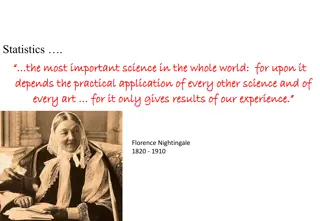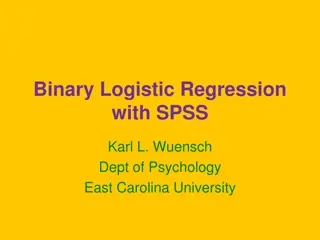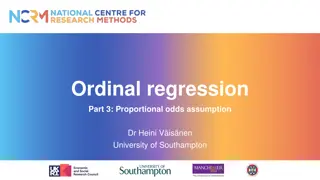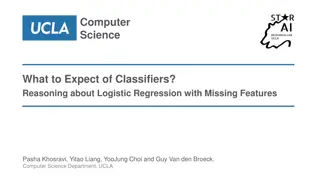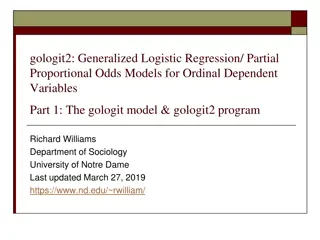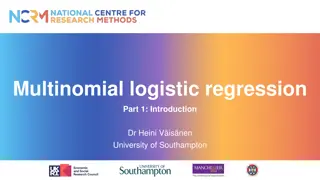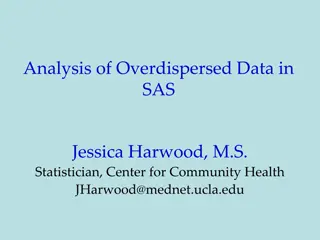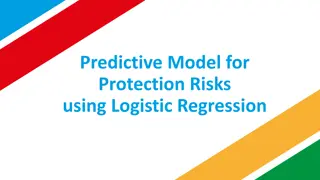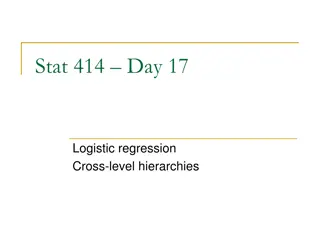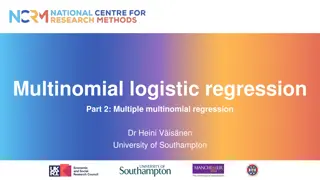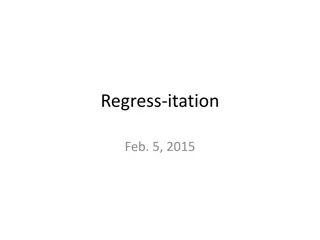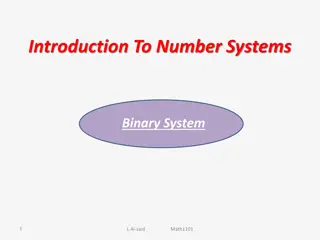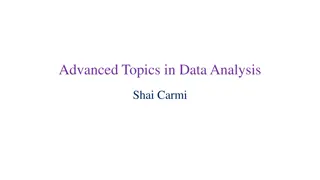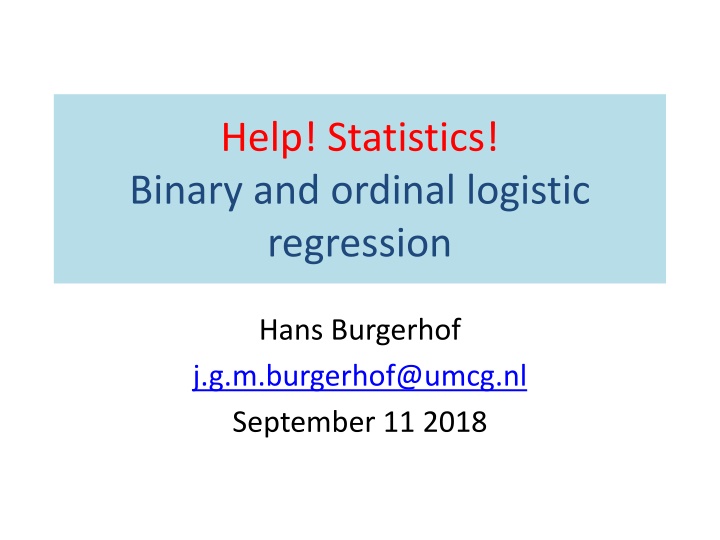
Binary and Ordinal Logistic Regression in Statistics
Dive into the world of binary and ordinal logistic regression in statistics with this comprehensive guide. Learn about interpreting coefficients, conducting tests, and checking assumptions to enhance your statistical modeling skills.
Download Presentation

Please find below an Image/Link to download the presentation.
The content on the website is provided AS IS for your information and personal use only. It may not be sold, licensed, or shared on other websites without obtaining consent from the author. If you encounter any issues during the download, it is possible that the publisher has removed the file from their server.
You are allowed to download the files provided on this website for personal or commercial use, subject to the condition that they are used lawfully. All files are the property of their respective owners.
The content on the website is provided AS IS for your information and personal use only. It may not be sold, licensed, or shared on other websites without obtaining consent from the author.
E N D
Presentation Transcript
Help! Statistics! Binary and ordinal logistic regression Hans Burgerhof j.g.m.burgerhof@umcg.nl September 11 2018
Help! Statistics! Lunchtime Lectures What? frequently used statistical methods and questions in a manageable timeframe for all researchers at the UMCG No knowledge of advanced statistics is required. When? Lectures take place every 2ndTuesday of the month, 12.00-13.00 hrs. Who? Unit for Medical Statistics and Decision Making When? Where? What? Who? Oct 9 2018 Nov 13 2018 Rode Zaal Room 16 Big data and machine learning Using causal graphs to unravel statistical paradoxes Non-parametrical tests ? ? C. Zu Eulenburg S. La Bastide Dec 11 2018 Feb 12 2019 Mar 12 2019 Room 16 ? ? D. Postmus ? ? Slides can be downloaded from http://www.rug.nl/research/epidemiology/download-area 2
Program Today Binary logistic regression - the outcome variable Y has two categories (success, failure) - interpretation of coefficients - Wald test / Likelihood ratio test - Pseudo-R - Hosmer Lemeshow test Ordinal logistic regression - the outcome variable has at least three, ordered, categories (SES, items with answers like strongly disagree strongly agree) - interpretation of coefficients - checking assumption of proportionality
The (simulated) dataset 1 = worse 2 = no effect 3 = small effect 4 = large effect 0 = failure 1 = success 0 = placebo 1 = drug
Binary logistic regression: Y = 0/1 Binary explanatory variable
Binary logistic regression: Y = 0/1 Binary explanatory variable treatment * Ybin Crosstabulation Odds(drug) = 183 Ybin 45 failure success Total treatment placebo Count % within 69 150 219 Odds(placebo) = 150 31,5% 68,5% 100,0% 69 treatment Count % within drug 45 183 228 19,7% 80,3% 100,0% treatment Count % within Total 114 333 447 25,5% 74,5% 100,0% treatment OR = 183 69 150 45 1.871 Odds Ratio (drug / placebo) of having a success Risk Estimate 95% Confidence Interval Lower 1,213 Value 1,871 Upper Odds Ratio for treatment 2,885 (placebo / drug) of having a failure!
Binary logistic regression: Y = 0/1 Binary explanatory variable
The SPSS output Likelihood Ratio test Pseudo R s Generally not of much use Odds Ratio of success for drug (1) compared to placebo (0)
Binary logistic regression: Y = 0/1 Binary explanatory variable (categorical) Odds Ratio of success for placebo (0) compared to drug (1) Variables in the Equation B S.E. Wald 8,030 71,078 df Sig. Exp(B) 0.535 = 1/1.871 Step 1a treatment(1) Constant -,626 1,403 ,221 ,166 1 1 ,005 ,000 ,535 4,067 a. Variable(s) entered on step 1: treatment.
Binary logistic regression One continuous covariate Example The covariate age may be grouped in classes Per age class, the proportion can be plotted A linear regression Can be performed Using the middle of the age classes as covariate Using the proportion as response variable Formation of age classes is somewhat arbitrary The linear model may exceed the range [0,1] for response 1.0 succes Proportion of LBW 0.5 0.0 20 30 40 age (years)
Binary logistic regression One continuous covariate Consider a possible age x The probability of success may be denoted by (x). This proportion (x) of successes can be transformed to the odds (x)/(1- (x)) The odds can range from zero to infinity The log odds ( logit ) can range from minus infinity to infinity Thus a natural model for the proportion (x) is + ( ) x ( x e + 0 1 = + log x = ( ) x 0 1 + 1 ) x x 1 e 0 1
Binary logistic regression One continuous covariate Example The response variable may be the log odds instead of the proportions This would overcome predictions outside the range [0 ; 1] A linear model in age for the log odds seems reasonable (figure) black dots are log odds open circles indicate CI
Binary logistic regression One continuous covariate Graphical representation of the proportion (x) 0.40 0.35 Range of covariate restricted to [15 ; 50] 0.30 (x) 0.25 y Example 0= 0.385 1= -0.051 0.20 0.15 . 0 . 0 385 051 x e + = ( ) x . 0 . 0 385 051 x 1 e 0.10 15 20 25 30 35 40 45 50 x x
Binary logistic regression One continuous covariate 1.0 Graphical representation of the proportion (x) 0.8 Range of covariate restricted to [-200 ; 200] 0.6 (x) y Example 0= 0.385 1= -0.051 0.4 0.2 . 0 . 0 385 051 x e + = ( ) x . 0 . 0 385 051 x 1 e 0.0 -200 -100 0 x 100 200 x
Binary logistic regression One continuous covariate ?(?) 1 ?(?)) The log odds (?? Is called the logit link function (other functions are possible too, such as the probit link function) Transforms the proportion into a linear model If the slope 1is Positive: the proportion increases with an increase in covariate x Negative: the proportion decreases with an increase in covariate x The intercept 0is related to the baseline proportion when the covariate takes the value zero
Binary logistic regression One continuous covariate Age is not a significant predictor here Variables in the Equation B S.E. Wald df Sig. Exp(B) Step 1a age Constant -,006 1,413 ,010 ,600 ,336 5,550 1 1 ,562 ,018 ,994 4,107 a. Variable(s) entered on step 1: age. 0.994 is the OR of having a success for an individual of a certain age, compared to an individual who is one year younger. What about comparing two individuals, differing ten years of age? The odds of success for the older person is 0.99410 0.94 times the odds for the younger person (so 6% lower)
Does the model fit? The Hosmer Lemeshow test Contingency Table for Hosmer and Lemeshow Test Ybin = failure Ybin = success Observed Expected 15,045 Observed Expected 29,955 Total Step 1 1 21 24 45 2 9 14,653 36 30,347 45 3 12 14,163 33 30,837 45 4 12 12,703 30 29,297 42 5 15 12,436 27 29,564 42 6 6 10,087 42 37,913 48 7 15 9,164 30 35,836 45 8 6 8,820 39 36,180 45 9 6 8,589 39 36,411 45 10 12 8,340 33 36,660 45 Hosmer and Lemeshow Test Null hypothesis HL test: model fits well Step 1 Chi-square 18,885 df Sig. 8 ,015
Multiple binary logistic regression Model Summary -2 log likelihood simple model (treatment): 499.426 Cox & Snell R Square Nagelkerke R Square Step 1 -2 Log likelihood 499,100a ,019 ,028 Difference 0.316 Not significant a. Estimation terminated at iteration number 4 because parameter estimates changed by less than ,001. Variables in the Equation B S.E. Wald df Sig. Exp(B) Step 1a treatment ,626 ,221 8,021 1 ,005 1,870 age -,006 ,010 ,326 1 ,568 ,994 Constant 1,112 ,606 3,363 1 ,067 3,040 a. Variable(s) entered on step 1: treatment, age.
Ordinal logistic regression 1 2 3 4 In modelling, cumulative probabilities are used: P(Y 1) = P(Y = 1) P(Y 2) = P(Y = 1) + P(Y = 2) P(Y 3) = P(Y = 1) + P(Y = 2) + P(Y = 3) P(Y 4) = 1
ORs for ordinal data Blue area: worse worse or no effect worse , no or small effect ?(? 1) 1 ?(? 1) ?(? 2) 1 ?(? 2) ?(? 3) 1 ?(? 3) ??1= ??2= ??3= ?(? 1) 1 ?(? 1) ?(? 2) 1 ?(? 2) ?(? 3) 1 ?(? 3) ??1= ??2= ??3= ??2 ??2 ??1 ??1 ??3 ??3 ?? = ?? = ?? = One common OR is estimated (assumption of parallel lines )
SPSS output of ordinal logistic regression (partly) Parameter Estimates 95% Confidence Interval Ln(??) = ?? ? ? Upper Estimate Std. Error Wald df Sig. Lower Bound Bound -1,10 Threshold [Yord = 1] -1,385 ,143 93,827 1 ,000 -1,665 Negative coefficient: placebo has lower probability for higher values [Yord = 2] [Yord = 3] -,278 ,838 ,127 ,133 4,786 39,422 1 1 ,029 ,000 -,526 ,576 1,099 -,029 Location [treatment=,00] [treatment=1,00] -,596 ,171 12,123 1 0 ,000 -,932 -,261 0a . . . . . Link function: Logit. a. This parameter is set to zero because it is redundant. Treatment = 1 (drug) is the reference Model Fitting Information Model Intercept Only -2 Log Likelihood Chi-Square df Sig. 44,658 Final 32,416 12,242 1 ,000 Link function: Logit.
Checking the assumption of parallel lines H0: lines are parallel (OR s are equal) Test of Parallel Linesa Model Null Hypothesis -2 Log Likelihood Chi-Square df Sig. 32,416 General 32,303 ,113 2 ,945 The null hypothesis states that the location parameters (slope coefficients) are the same across response categories. a. Link function: Logit. If the assumption is not fulfilled: use Multinomial logistic regression Three OR s are estimated
Does the model fit? Cell Information Frequency Yord treatment placebo worse no effect small effect large effect 51 Observed 69 57 42 Expected 68,4 58,4 50,0 42,2 Pearson Residual ,082 -,208 ,153 -,027 drug Observed 45 54 60 69 Expected 45,7 52,6 60,9 68,9 Pearson Residual -,109 ,217 -,129 ,020 Link function: Logit. Goodness-of-Fit Chi-Square df Sig. Pearson ,113 2 ,945 Deviance ,113 2 ,945 Link function: Logit.
Several link functions for ordinal data (SPSS manual, chapter 4) The interpretation of the coefficients will differ, depending on the linkfunction used
Some literature SPSS manual, chapter 4 (Ordinal Logistic Regression): http://www.norusis.com/pdf/ASPC_v13.pdf McGullagh and Nelder: Generalized Linear Models (Chapman & Hall, reprinted 1991) Hosmer and Lemeshow: Applied Logistic Regression (Wiley 1989)

